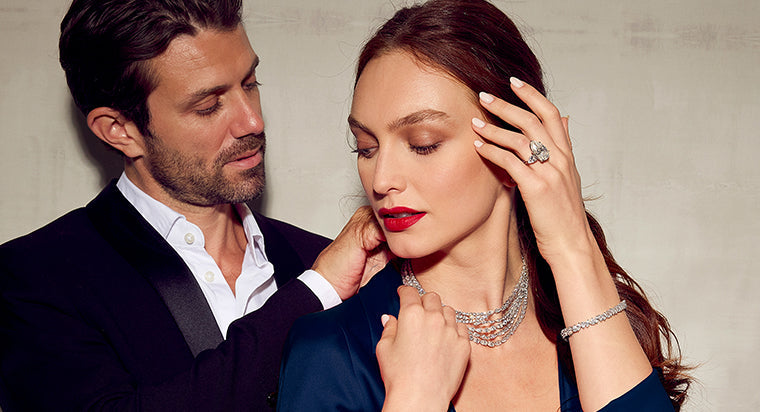A Guide to Valuing and Investing in Jewelry in Today's Market

There are certain things you can buy that are considered worthy investments. That is because their value does not usually decrease over time. Depending on the market, it can even increase.
Jewelry, especially diamond gemstone rings, or diamonds in general, is one of these items. High-quality jewelry with gemstones and fine metal tends to hold onto its resale value. Compared to other big-ticket items, such as a car, its ability to be resold for the purchase price or even more doesn't decrease with age or sometimes even use. Earrings, bracelets, necklaces - practically any high-quality jewelry piece you buy can be resold anytime, and you're almost guaranteed to get back your initial cost. Alternatively, if you pass it on to your children or grandchildren, the jewelry piece will continue to hold its value for generations.
It's hard to go wrong with diamond jewelry investments. Still, there are a few factors to consider.
TABLE OF CONTENTS
Understanding Value
There are different aspects of value when it comes to jewelry. Intrinsic value is how much something is worth, regardless of the fluctuating market. For example, gold, silver, and platinum have been and will continue to be valuable. Although the market price may change, precious metals like these will never be considered worthless.
Similarly, high-quality gemstones, including diamonds, emeralds, sapphires, and rubies, possess intrinsic value. When found in excellent quality in their natural form, they're highly coveted for use in jewelry. Gemstones have reigned supreme when it comes to adornment for centuries. It's also true that many gemstones have industrial uses that make them extremely valuable, especially as they are non-renewable resources.
Other characteristics can also play a role in their value outside the intrinsic value of metals and gemstones. Design, brand, and craftsmanship can impact a jewelry piece's resale value. Round brilliant diamonds fetch the highest price thanks to the beauty of the cut.
If the brand, gemstone, or jewelry piece has been around for a long time, like a wedding band usually is, its value can also increase. Historical provenance and rarity command higher value due to their uniqueness and significance.
Appraisals
It's important to note that without proper documentation, the value of your jewelry piece can be unstable. Appraisals are crucial for insurance, resale, and a general understanding of the value of your jewelry.
A skilled appraiser can often confirm the authenticity of your jewelry. That is, as long as you choose a qualified and certified appraiser. Often, these individuals will have credentials from renowned organizations like the Gemological Institute of America (GIA) or the American Society of Appraisers (ASA). During an appraisal, they will inspect and analyze your piece. Descriptions covering your piece's measurable and visible aspects, like carat weight, will be recorded. Then, its quality will be assessed to determine the item's value, and documentation will be provided to back up the estimation.
Generally, appraisals can provide a few different types of valuation. Including:
- Insurance Appraisal: This is used to insure jewelry against theft or damage. The number given is how much you could reasonably expect to pay to replace the damaged or stolen item.
- Fair Market Value Appraisal: This appraisal is for resale purposes. It is how much a buyer and seller could expect to settle on if they were not under pressure or time constraints to make a sale. It considers the jewelry piece in its current state and the most common market.
- Estate Appraisal: For inheritance and estate planning. The number is usually similar to fair market value, based on the piece's current (used) condition in a fair market value scenario.
Fortunately, diamonds tend to do well in all appraisal situations. However, getting your jewelry appraised periodically is necessary to ensure the given value isn't inflated or too low.
Market Trends
Current market trends show that jewelry is expected to grow at a Compound Annual Growth Rate (CAGR) of 4-6%. Many up-and-coming jewelry buyers still see precious metals and gemstones as an investment, but what they're looking for is shifting.
When it comes to investment trends, many shoppers are looking for pieces that are ethically sourced and sustainable. While natural diamonds still occupy the top spot in terms of value, consumers want their gems to make the least impact on the environment and the people involved in their sourcing and processing as possible.
Enter lab-grown diamonds. In recent years, lab-grown diamonds have been increasingly preferred and have captured a larger market share, especially for engagement rings. These diamonds are often more affordable and considered a more ethical and sustainable than mined diamonds.
Economic factors, like inflation and geopolitical events, can disrupt the jewelry market and reduce consumer spending power, decreasing demand for luxury items such as jewelry. Nevertheless, precious metals and gemstones often retain their intrinsic value and remain worthy investments despite market fluctuations. Additionally, with the demand for vintage pieces is rising, it is usually worthwhile to hold onto jewelry pieces and wait out downturns in the market. When you are ready to sell again, your classic piece may be valued even higher than you imagined.
Tips for Investors
High-quality jewelry from certified and reputable jewelers is an excellent investment. If you're considering purchasing a valuable piece of jewelry, here is what to consider.
- Research and Education: Thorough research and continuous education about jewelry and market conditions are necessary for purchasing a piece that will retain and/or increase its value. Certain brands, styles, and gemstones have historically performed better than others. Paying attention to these precedents and trends is beneficial.
- Diversification: Diversifying investments across different types of jewelry and other assets can help provide you peace of mind and cover yourself should something not perform as well as you had hoped. For example, diamonds, gold, and platinum all do well, with rings being one of the best investments. However, pendant necklaces and bracelets have also become much sought-after pieces.
- Authentication and Certification: Whichever jewelry type you choose, always buy authenticated and certified pieces to ensure quality and authenticity. This will help justify the value of your piece should you want to insure it, sell it, or pass it down.
- Storage and Insurance: As with most items, the better condition it is in, the better its value will be. Take proper steps to care for and maintain your jewelry, especially if you wear it instead of locking it away.
Investing in Beauty and Brilliance
Investing in jewelry is not like any other investment. Not only do these accessories offer an amazing return on investment, but they also allow you to enjoy them while their value increases. Unlike gold bars or coins, you can slip your diamond ring on your finger or don your favorite pair of ruby earrings and flaunt your gorgeous taste.
As long as you have assessed the quality and rarity of the piece and researched market behavior and trends, your jewelry investment should perform well over the long haul. Working with a reputable and certified jeweler like With Clarity can help. They can provide guidance, support, and tips to boost not only your portfolio but also your personal style.








